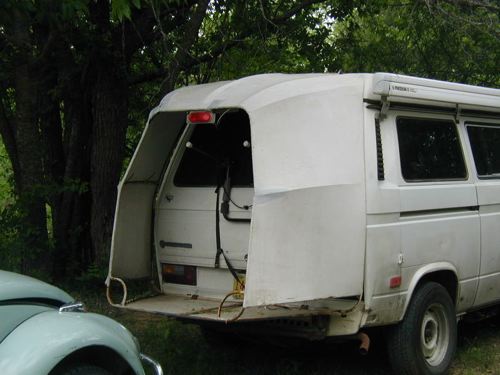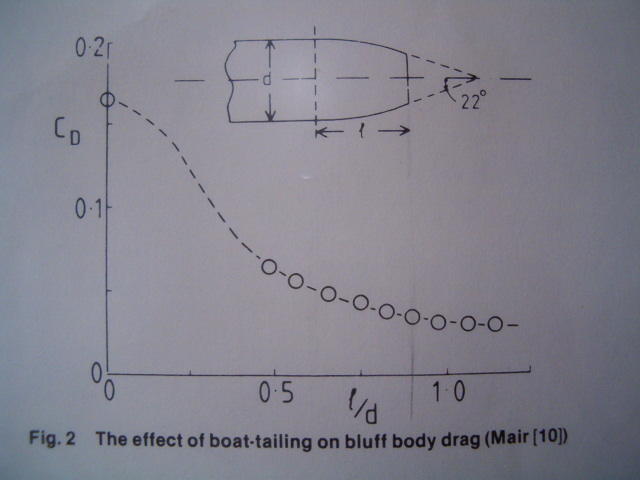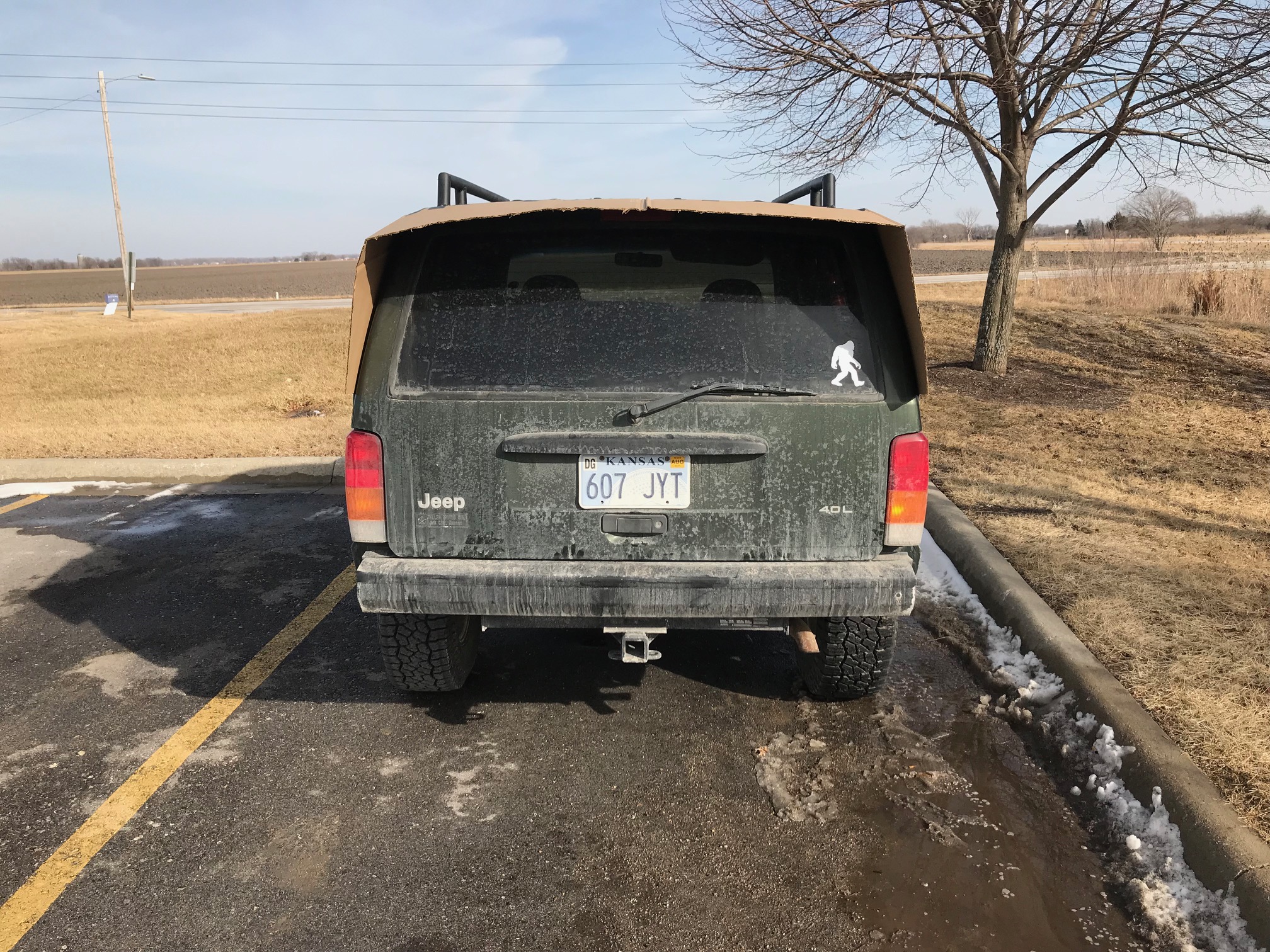I used AABBAA testing to probe any potential improvements to Fuel Economy from adding a kammback to my 1997 Jeep Cherokee. I'm going to share as many details, numbers, and observations as I can and so you can come up with your own conclusion.
Background info: I've started working on getting decent FE from my adventuremobile. One or two times a year, I go on long offroad roadtrips aka overlanding. Most of the miles are still on the highway though, and I'm tired of getting 17 mpg at 70mph. So I've started to make little improvements, and
you can read about them on my build thread. Other eco improvements will include upgrades to the engine, reducing rolling resistance, and other aero mods like wheel spats, air dam, and belly pan.
 Hypothesis
Hypothesis
It's long been said that the big aero money is in shrinking the size of the wake that drags the vehicle back. On my big bluff body SUV, I've identified two or three ways this could be accomplished: boat tail, open boxed cavity, spoiler (not as likely but it's possible I guess).
We all know what a kammback is, but I'm fairly new here and from what I understand, a kammback is like a chopped boat tail.

And here's an open boxed cavity. If you've ever driven on the highway, you know what this is even if you don't know that you know..

So, and I'm no expert, but it seems to me that if you combine a kammback and an open boxed cavity, you get what I call the open ended kammback and what others might call a fluid tail.
Quote:
|
Originally Posted by freebeard
|
Another example of an open boxed cavity that also takes on a kammback shape:

On last example. This is minivan that MetroMPG did:
http://ecomodder.com/forum/showthrea...-6-a-6069.html

^^^ MetroMPG found that he could get a 3.7% boost in FE with an open-ended kammback that is, frankly, larger then I would want permanently.
There was an
even better illustration on aerohead's sabataged photobucket gallery, but this one is similar. It shows that, as a function of the length of the kammback over the width of the bluff body vehicle, the reduction in drag coefficient is significant starting at maybe 30% (that is, the kammback should be at least 2 feet long for a 6 foot wide vehicle). IIRC, aerohead's illustration was less optimistic.
 So based off that, my hypotheses is that I could possibly see a small to moderate boost in fuel efficiency with an open-ended kammback that's about one to two feet long.
Testing Procedure
So based off that, my hypotheses is that I could possibly see a small to moderate boost in fuel efficiency with an open-ended kammback that's about one to two feet long.
Testing Procedure
Last Thursday I had the day off from work and it was a nice and warm (for February) day with not too much wind (for the midwest).
I identified the perfect road. We call it "old K10" because it used to be Kansas highway 10 but they built a new highway that runs parallel to it and that's where all the traffic is now, so this road is not only mostly traffic free but the speed limit is a nice 55 mph. And it's PERFECTLY FLAT because it's located on river bottom land. So it's surrounded by farms. And it's almost 4 miles long in the flat spot. And there's good spots to pull over at the start and end. Perfect!
Here's what I did: I drove to the start of the "test track" and that was several miles so I think that was enough to warm the vehicle up. Then I did two A runs (there and back), then two B runs with the kammback on, then two C runs with the kammback slightly adjusted to be more curvy, and then two A runs.
I used my new
$20 obdii wifi dongle that I connect to a $5 iOS app to get my fuel consumption readings. It took some practice learning how to use it, and I found that the best way was to use the "economizer" feature of the app, and then snap a screenshot after the drive.
I started on the West end of the test track (I used a parking lot for a call center), drove the ~3.6 miles (it starts to get hilly after that), pull off onto a side road and take a snap shot of the obdii app, turn around and drive back and pull into the parking lot and take another screen shot.
I don't have cruise control, so I could not totally remove myself as the driver from the experiment. However I made sure to accelerate at 2k RPM and take my foot off the gas pedal at exactly the same spot. And I tried to keep it at exactly 55 mph, though I admit it did range from 53 to 57 mph.
The experiment
The first two A runs went smoothly. Then I parked in the parking lot and began cutting the cardboard and taping it to the back of the jeep. I had to work fast because I didn't want the car to cool down too much. If you don't think it's all that windy out, try taping a big piece of cardboard to the top of a vehicle and you'll think twice! That's about the time I realized that it was more windy then I originally thought, and it seemed to me that the wind was coming mostly from the South. I would say South South West.
I used "gaffer tape" and it worked really really well and didn't leave any residue on the car.



I tried to make it straight with a ~10% slope. I think I remember hearing somewhere that Wunibald Kamm said the slope of the roof shouldn't excede 10%.
Then I drove the course just as before. Maybe it was in my head but it did seem like the car was more "slippery" lol.
Back in the parking lot, cut up the corners of the cardboard a little so I could bend them and add a slight curve to it. In hindsight, it doesn't look like I did much to it. Also, when I went to remove it, the packaging tape I used to pull it down towards the rear window had loosed up on the window, so the curve was even less pronounced.

It addition to that, my obdii scan app crashed on the way back so I only got one run in. For this reason and the other one above, I'm all but throwing out this information.
Finally, I did two more A runs and then went home to add up the numbers.
Results

X1 is traveling East, and X2 is traveling West back to the start. A2 and A4 are longer then B2 because the app reset when turned around after B1. I just subracted the A1 numbers from A2 (and same for A4) to get the numbers here:
 Analysis
Analysis
So that's exactly 1 mpg better with the kammback on. Woo hoo!!
1/19.64 = 5.1% and I think that's pretty significant.
However, if you look closer at the numbers, a few things should jump out at you:
- the mileage isn't exactly the same
- The A3 run was by far the best, at 22.3 mph.
So why was the mileage not exactly the same? Well, when I turned around to head back West onto the side road, I kept having to drive a few yards further each time because of traffic. I think an elementary school got out around that time and parents where crawling that area to pick them up.
And why was the third A run the best?
I don't really have an answer for that one. If you look at
the weather history for that day, the wind didn't shift but it did start to slow down around 3:30pm which is when I started the last to A runs.
Conclusions
The experiment wasn't perfect and is certainly not rigorous by any stretch of the imagination. I wish the road was longer, the wind didn't shift, I had cruise control, there was less traffic at my turnaround point, the app didn't crash during the second C run, etc.
But I'm fairly confident that making a permanent version of this out of sheet metal could get me around 1 mpg better then before, and possible even more at higher speeds. The open ended kammback is a go!
What do you think?